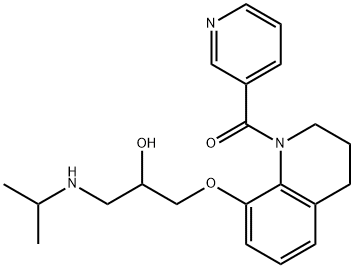76252-06-7
 76252-06-7 結(jié)構(gòu)式
76252-06-7 結(jié)構(gòu)式
基本信息
(8-(2-羥基-3-(異丙胺基)丙氧基)-3,4-二氫喹啉-1(2H)-基)(吡啶-3-基)甲酮
Nicainoprol
Nicainoprolhe
1,2,3,4-tetrahydro-8-[2-hydroxy-3-(isopropylamino)propoxy]-1-(3-pyridylcarbonyl)quinoline
1,2,3,4-Tetrahydro-8-[2-hydroxy-3-[(1-methylethyl)amino]propoxy]-1-(3-pyridinylcarbonyl)quinoline
Methanone, [3,4-dihydro-8-[2-hydroxy-3-[(1-methylethyl)amino]propoxy]-1(2H)-quinolinyl]-3-pyridinyl-
物理化學(xué)性質(zhì)
| 報(bào)價(jià)日期 | 產(chǎn)品編號(hào) | 產(chǎn)品名稱(chēng) | CAS號(hào) | 包裝 | 價(jià)格 |
| 2024/11/08 | HY-100572 | 尼卡普醇 Nicainoprol | 76252-06-7 | 1mg | 1330元 |
| 2024/11/08 | HY-100572 | 尼卡普醇 Nicainoprol | 76252-06-7 | 5mg | 3370元 |
常見(jiàn)問(wèn)題列表
Sodium Channel
The antiarrhythmic agent Nicainoprol, a fast-sodium-channel blocking drug, also protected isolated rat hearts against reperfusion arrhythmias, but is without beneficial effects on cardiac hemodynamics and biochemical parameters, in contrast to the ACE inhibitor.
The effect of the novel antiarrhythmic agent Nicainoprol on coronary occlusion and reperfusion arrhythmia is investigated in isolated working rat hearts and in anesthetized rats. In isolated working rat hearts Nicainoprol (10 μM, 5 μM and 100 μM) induces concentration-related protection against reperfusion arrhythmia without changing the cardiodynamics, with the exception of a decrease in heart rate at the highest concentration. Enzyme levels (lactate dehydrogenase and creatine kinase) in the coronary venous effluent, and cardiac tissue concentrations of glycogen, lactate, ATP and creatine phosphate are not affected by Nicainoprol. Given to anesthetized rats, Nicainoprol (5 and 10 mg/kg i.v.) reduces dose dependently in the early post occlusion (0-30 min) period, the percentage of animals with premature ventricular complexes (PVCs) and ventricular tachycardia while completely preventing the occurrence of ventricular fibrillation. In the reperfusion period no animal treated with 5 mg/kg and 12% of the rats treated with 10 mg/kg showed PVCs (the only form of arrhythmia observed in this period) versus 60% of the control rats. Both doses of Nicainoprol induces a decrease in heart rate, blood pressure and myocardial oxygen consumption. The ratio of infarct mass to ventricular mass is significantly reduced by 20% at a dose of 5 mg/kg and by 28% at the dose of 10 mg/kg. Nicainoprol could be useful in the prevention and treatment of arrhythmias associated with acute myocardial infarction.
